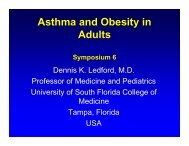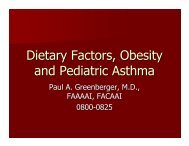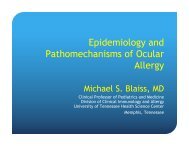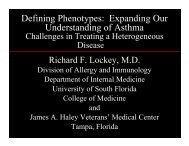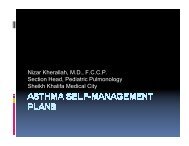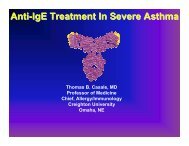Dubai Final-v20.indd - World Allergy Organization
Dubai Final-v20.indd - World Allergy Organization
Dubai Final-v20.indd - World Allergy Organization
Create successful ePaper yourself
Turn your PDF publications into a flip-book with our unique Google optimized e-Paper software.
ABstrACts<br />
ABstrACts<br />
recognized cause of COPD, most of sri- lankan women are non smokers. therefore females having COPD become an important<br />
group to study aetiology of COPD other than smoking.the aim of this study is to identify causes of COPD in females of Kandy, sri<br />
lanka.<br />
method: the study consisted of 54 patients who were diagnosed of having COPD on the basis FEV1/ FEC ratio of below 70%<br />
and had bronchodilator reversibility of less than 12%. the cohort of patients was selected from patients investigated for cough<br />
and dyspnoea presented to the Chest Clinic, Kandy for a period of 9 months from 01 Jul 2008 to 31 mar 2009 the study group<br />
of patients was interviewed using a prepared questionnaire .their demographic data including social status was recorded . the<br />
aetiologies of smoking recurrent chest infections in early childhood and indoor air pollution were recorded<br />
results: the age range of the patients was 48y to 82y with a mean age of 69.8y. All the patients were life time nonsmokers. 26%<br />
reported to have inhaling secondhand smoke from one or more household smokers. Only 7% had recurrent chest infections<br />
in childhood. 82% of patients had exposure to indoor air pollution in the form of using firewood for cooking in under ventilated<br />
kitchens. 88% of the patients were form suburban and rural areas and 68% belonged to poorer social classes. in spite of the high<br />
literacy ratio of srilana 5.2% of the study population was illiterate.<br />
Conclusion: indoor air pollution is a significant cause of COPD in women of Kandy, sri lanka COPD .affects women of poorer social<br />
strata. since around 80% of sri lankan households use firewood for cooking, it is very important to improve standards of cooking<br />
and ventilation in kitchens,and to empower women with knowledge in causative factors and prevention of COPD.<br />
PoSTEr SESSion 1-4: rhinitis, rhinosinusitis and conjunctivitis<br />
1400<br />
SElECT ParamETErS rElaTing To THE maXimal inSPiraTorY anD EXPiaTorY FloW raTE among THE rUral<br />
PoPUlaTionS inHaBiTing THE arEaS aroUnD ZamoSC, PolanD – a FolloW-UP To THE mUlTi-CEnTEr STUDY ECaP<br />
(EPiDEmiologY oF allErgiC DiSEaSES in PolanD)<br />
Krzych-Falta, Jr., E. 1 , samoliñski, B. 2 , lusawa, A. 1 , rojek, B. 1 and Kapalczynski, W. 3<br />
1Department of Prevention of Environmental Hazards and Allergology, Warsaw medical University, Department of Clinical Allergol,<br />
medical Uniwersity of Warsaw, Warsaw, Poland. 2Department of Prevention of Environmental Hazards and Allergology, Warsaw<br />
medical University, Department of Clinical Allergol, m, medical Uniwesity of Warsaw, Warsaw, Poland. 3University of louisville school<br />
of medicine, louisville, United states, University of louisville school of medicine,, United states.<br />
the objective of this study is to determine the average value of various upper and lower respiratory tract parameters (PniF, FEV1,<br />
FEV1/VC) as they relate to a patient’s clinical diagnosis. All diagnoses were made during medical examination by a physician based<br />
on specific criteria. the study encompassed 288 ECAP participants (96 participants 9-10 years of age, 84 participants 16-17 years<br />
of age, and 108 participants 23-47 years of age) residing in the areas surrounding ZamoϾ. research methods employed included<br />
spirometry and the measurement of peak nasal inspiratory flow in l/min using a specially constructed mask. For analysis of the<br />
results, the participants were divided into three groups:<br />
- Patients diagnosed with seasonal rhinitis- mean values: PniF: 90.23 l/min, FEV1: 99.27%, FEV1/VC: 101.95%<br />
- Patients diagnosed with perennial rhinitis- mean values: PniF: 99.93 l/min, FEV1: 98.77%, FEV1/VC: 98.83%<br />
- Patients with diagnosed asthma including:<br />
- light asthma- mean values: PniF: 86.15 l/min, FEV1: 90.31%, FEV1/VC: 96.15%.<br />
- moderate asthma- mean values: PniF: 92.5 l/min, FEV1: 89%, FEV1/VC: 93.25%,<br />
- Severe asthma- mean values: PniF: 87.23 l/min, FEV1: 87.73%, FEV1/VC: 95.45%.<br />
in conclusion, the lowest values for the selected upper and lower respiratory tract parameters were obtained from the group of<br />
patients diagnosed with bronchial asthma, especially severe asthma.<br />
1401<br />
THE aSSoCiaTion BETWEEn DEgrEE oF SEnSiTiZaTion To allErgEn anD SEVEriTY oF allErgiC rHiniTiS<br />
mohd Ashari, n. s. , Wm, W. m. , Y, n. K. , sah, s. and CH, C. m.<br />
immunology, Universiti sains malaysia, Kota Bharu, malaysia.<br />
Allergic rhinitis is the most common allergic disease affecting an estimated four million people in malaysia. Although allergic<br />
rhinitis is not usually severe diseases, it significantly alters the social life of patients and affects school learning performance as<br />
well as work productivity. this study was done to determine the levels of allergen specific immunoglobulin E assay in allergic<br />
www.worldallergy.org 112<br />
FinAl PrOgrAm





